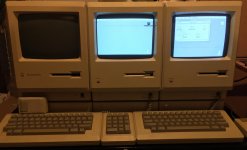Anonymous Freak
Well-known member
Well, in the Craigslist finds thread, there was an ad local to me with a *LOT* of great gear - Power Mac G3 with original dark blue Studio Display, color NextStation Turbo, Mystic Color Classic, etc. I replied within a couple hours of the ad going live, but someone else had beaten me to it, and gotten most of the "good stuff."
But, left over were a "Macintosh 512K" and an Apple IIe with a bunch of expansion cards. (And a not-working HD20.)
So I went by and picked them up. Turns out the seller is a 68kmla member who basically forgot the forum existed. (Hi, unknown-user-name!).
Took home my ill-gotten goods. (Okay, perfectly legitimately-gotten,) played with them, and got everything all nice and cozy.

It's the one on the far right - on top of my working HD20. (I decided to line up all my "pre-Snow White" compact Macs.) And I noticed something odd - it booted from the HD20 without the "bootstrap" disk. Likewise, its internal drive can read 800k floppies just fine. Hey! This is a 512Ke, not a 512K! (I emailed him with my discovery, and he replied "you know, I knew that, I just forgot when posting the ad.")
I had my one working HD20, plus a dead HD20. I decided to see if I could cobble together one working HD20 between my broken one and the broken one I just got. Nope. The drive in the new one spins (better than in my previous broken one,) and the OS knows it's plugged in and offers to format it - but I just can't get it to format. Oh well.
It's nice having a "complete set" of compact Macs now. And now if I can find an original release-model 128K logic board, I won't feel bad about swapping it in my 128 (which got a 512K upgrade at some point.)
But, left over were a "Macintosh 512K" and an Apple IIe with a bunch of expansion cards. (And a not-working HD20.)
So I went by and picked them up. Turns out the seller is a 68kmla member who basically forgot the forum existed. (Hi, unknown-user-name!).
Took home my ill-gotten goods. (Okay, perfectly legitimately-gotten,) played with them, and got everything all nice and cozy.

It's the one on the far right - on top of my working HD20. (I decided to line up all my "pre-Snow White" compact Macs.) And I noticed something odd - it booted from the HD20 without the "bootstrap" disk. Likewise, its internal drive can read 800k floppies just fine. Hey! This is a 512Ke, not a 512K! (I emailed him with my discovery, and he replied "you know, I knew that, I just forgot when posting the ad.")
I had my one working HD20, plus a dead HD20. I decided to see if I could cobble together one working HD20 between my broken one and the broken one I just got. Nope. The drive in the new one spins (better than in my previous broken one,) and the OS knows it's plugged in and offers to format it - but I just can't get it to format. Oh well.
It's nice having a "complete set" of compact Macs now. And now if I can find an original release-model 128K logic board, I won't feel bad about swapping it in my 128 (which got a 512K upgrade at some point.)
